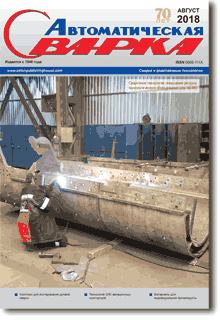| 2018 №08 (07) |
DOI of Article 10.15407/as2018.08.08 |
2018 №08 (01) |

Avtomaticheskaya Svarka (Automatic Welding), #8, 2018, pp. 45-50
Methodology of determination of induction of controlled magnetic field in pool zone during arc welding
A.D. Razmyshlyaev1, P.A. Vydmysh2, M.V. Ahieieva3
1State Higher Eductation Instittue Pryazovskyi State Technical University 7, Universitetskaya Str., 87500, Mariupil, Ukraine. Е-mail: razmyshljаеу@gmail.com
2OJSC «Metinvest-Promservis», 113-а Nikopol ave., 87500, Mariupil, Ukraine, Е-mail: pstukmu@gmail.com
3Donbass State Machine Building Academy, 72, Akademicheskaya str., 84313, Kramatorsk, Ukraine. Е-mail: maryna_ah@ukr.net
Abstract
It is shown that at the present time the calculation methods, which allow determining induction in the weld pool zone, which is generated by two-rod devices for input of transverse magnetic field during arc welding. However, these methods are extremely difficult to use. In this paper, the calculation methods for determining numerical values of the induction components of a transverse magnetic field in the weld pool were proposed. The methods are based on the use of experimental data on the value of the induction generated by the transverse magnetic field input device in the weld pool zone at different value of rod cross-sections of these input devices. The calculation expressions and an algorithm for their use are proposed to determine the magnetic field induction components in the indicated zone. The satisfactory convergence of the calculated data with the experimental ones is shown. The methods are recommended for using in arc surfacing and welding of products of materials which are not ferromagnetics. 8 Ref., 6 Fig.
Keywords: transverse magnetic field, induction, ferromagnetic, welding pool
References
- Skipersky, N.A., Rybachuk, A.M. (2000) Weld formation by transverse magnetic field in welding of nonmagnetic materials. Svarochn. Proizvodstvo, 7 , 53-55 [in Russian].
- Iofinov, P.A., Ibragimov, V.S., Dmitrienko, A.K. et al. (1991) Effect of external electromagnetic field on speed of electrode wire melting in automatic submerged-arc welding. Ibid., 1 , 34-35 [in Russian].
- Razmyshlyaev, A.D., Mironova, M.V., Kuzmenko, K.G. et al. (2011) Efficiency of melting of electrode wire in submerged-arc surfacing with influence of transverse magnetic field. The Paton Welding J., 5 , 39-42.
- Ryzhov, R.N., Kuznetsov, V.D. (2006) External electromagnetic effects in the processes of arc welding and surfacing (Review). Ibid., 29-35.
- Andreeva, E.G., Shamets, S.P., Kolmogorov, D.V. (2005) Calculation of stationary magnetic fields and characteristics of electrical devices using program package ANSYS. Electron. Sci. J. Oil and Gas Business, 1 . http//ogbus.ru/authors/Andreeva/Andreeva_1.pdf.
- Bessonov, L.A. (2003) Theoretical fundamentals of electrical engineering. Electromagnetic field. Moscow, Gardariki [in Russian].
- Tozoni, O.V. (1975) Method of secondary sources in electrical engineering. Moscow, Energiya [in Russian].
- Razmyshlyaev, A.D., Mironova, M.V., Yarmonov, S.V., Vydmysh, P.A. (2013) Structure of transverse magnetic field generated by input devices for arc welding processes. Visnyk Pryazov. DTU: Transact. Mariupol, 26 , 135-141 [in Russian].
Received: 12.06.2018
Published: 19.07.2018.
